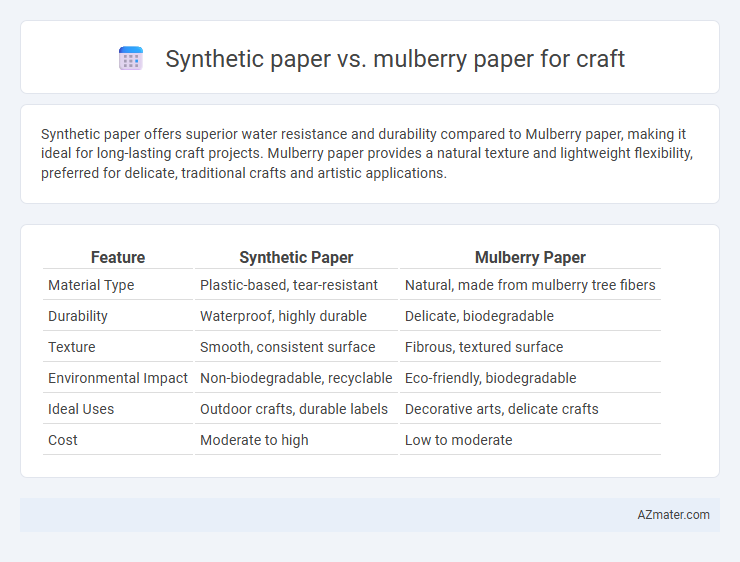Synthetic paper offers superior water resistance and durability compared to Mulberry paper, making it ideal for long-lasting craft projects. Mulberry paper provides a natural texture and lightweight flexibility, preferred for delicate, traditional crafts and artistic applications.
Table of Comparison
| Feature | Synthetic Paper | Mulberry Paper |
|---|---|---|
| Material Type | Plastic-based, tear-resistant | Natural, made from mulberry tree fibers |
| Durability | Waterproof, highly durable | Delicate, biodegradable |
| Texture | Smooth, consistent surface | Fibrous, textured surface |
| Environmental Impact | Non-biodegradable, recyclable | Eco-friendly, biodegradable |
| Ideal Uses | Outdoor crafts, durable labels | Decorative arts, delicate crafts |
| Cost | Moderate to high | Low to moderate |
Introduction to Synthetic and Mulberry Papers
Synthetic paper offers waterproof, tear-resistant qualities made from plastic polymers, making it ideal for durable craft projects requiring longevity and weather resistance. Mulberry paper, crafted from the fibers of the mulberry tree bark, provides a natural, textured surface prized for its lightweight yet strong characteristics in delicate and artistic crafts. Both materials differ significantly in composition and durability, influencing their suitability for various creative applications.
Composition and Manufacturing Process
Synthetic paper is made from plastic polymers like polypropylene or high-density polyethylene, offering waterproof and tear-resistant properties through extrusion or calendaring processes. Mulberry paper is crafted from the inner bark fibers of the mulberry tree, utilizing traditional hand-processing techniques that involve soaking, beating, and laying fibers to dry, resulting in a delicate, fibrous texture. The synthetic paper's industrial manufacturing contrasts with mulberry paper's eco-friendly, natural fiber extraction, defining their distinct durability and artistic applications in crafts.
Texture and Appearance Comparison
Synthetic paper offers a smooth, consistent texture with a glossy or matte finish, ideal for vibrant printing and precise detailing in craft projects. Mulberry paper features a delicate, fibrous texture with natural variations and a slightly translucent appearance, enhancing projects with an organic, handcrafted feel. While synthetic paper provides durability and water resistance, mulberry paper is prized for its unique, tactile quality and traditional aesthetic.
Durability and Strength Differences
Synthetic paper offers superior durability and resistance to water, tearing, and chemicals compared to mulberry paper, making it ideal for long-lasting craft projects. Mulberry paper, made from natural fibers, provides a delicate texture and flexibility but is more prone to tearing and damage from moisture. For crafts requiring strength and endurance, synthetic paper is the preferred choice due to its robust composition and enhanced tear resistance.
Environmental Impact and Sustainability
Synthetic paper, made from polypropylene or polyethylene, offers durability, water resistance, and recyclability but is derived from petrochemicals which raises concerns about fossil fuel dependence. Mulberry paper, crafted from natural mulberry tree fibers, is biodegradable, compostable, and sourced from renewable plants, making it more environmentally sustainable and promoting reduced waste in crafts. Choosing mulberry paper supports sustainable forestry and minimal environmental pollution, whereas synthetic paper prioritizes longevity and recyclability but may contribute to plastic pollution if not properly managed.
Versatility in Craft Applications
Synthetic paper offers exceptional versatility in craft applications due to its water resistance, durability, and ability to accept various inks and paints without smudging or bleeding. Mulberry paper, known for its lightweight texture and natural fibers, excels in delicate projects such as paper quilling, scrapbooking, and collage where a traditional, handcrafted aesthetic is desired. Both materials serve distinct roles: synthetic paper is ideal for long-lasting, water-resistant crafts, while mulberry paper provides a unique tactile quality suited for intricate and artistic designs.
Printability and Coloring Performance
Synthetic paper offers superior printability due to its smooth, non-porous surface that allows for sharp, vibrant images with less ink absorption, making it ideal for detailed crafting projects. Mulberry paper, with its fibrous, textured composition, provides a unique artistic effect but can result in less consistent color application and may require specialized inks for optimal coloring performance. Craft projects demanding precise, high-quality prints benefit more from synthetic paper, while those favoring a natural, handcrafted aesthetic may prefer the visual and tactile qualities of mulberry paper.
Cost and Availability Analysis
Synthetic paper offers higher durability and water resistance compared to Mulberry paper but comes at a higher price point, typically ranging from $1.50 to $3.00 per sheet, making it less accessible for budget-conscious crafters. Mulberry paper, known for its natural texture and eco-friendly properties, is generally more affordable with prices around $0.50 to $1.50 per sheet and is widely available from specialty craft stores and online retailers. Availability of synthetic paper can be limited to specialty suppliers, whereas Mulberry paper benefits from broader distribution channels, especially in Asian markets and craft stores worldwide.
User Experience and Handling
Synthetic paper offers a smooth, tear-resistant surface that enhances durability and allows for easy handling during intricate craft projects, making it ideal for users seeking long-lasting materials. Mulberry paper, known for its lightweight, fibrous texture, provides a natural tactile experience favored by artisans for delicate techniques like embossing and layering. While synthetic paper excels in moisture resistance and consistency, Mulberry paper delivers superior flexibility and a traditional aesthetic valued in fine craftwork.
Choosing the Right Paper for Your Craft Project
Synthetic paper offers durability, water resistance, and tear-proof qualities, making it ideal for outdoor or high-use craft projects. Mulberry paper provides a delicate texture and natural fibers, perfect for intricate designs, scrapbooking, and traditional handicrafts. Choosing the right paper depends on project requirements like longevity, texture, and environmental exposure.

Infographic: Synthetic paper vs Mulberry paper for Craft
 azmater.com
azmater.com